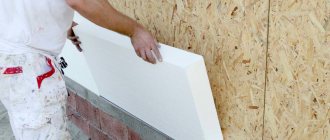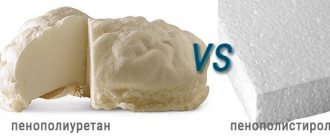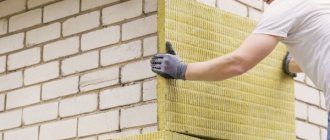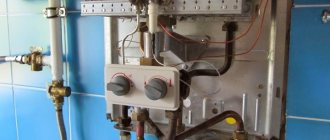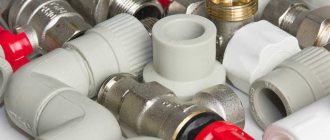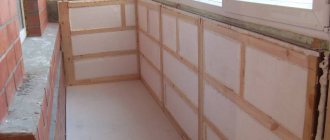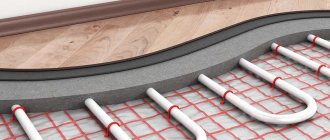In order to provide warmth in the house and reduce energy costs for heating the building, they resort to insulating the facade.
The insulation process is a simple type of work; it can be done independently and does not require the use of special equipment or the involvement of specialists.
Insulation of the facade can be done in several ways using various insulating materials.
One of the popular insulation materials, which is widely used for external wall insulation, is polystyrene foam.
We present to your attention a master class on how to insulate a facade yourself.
Which polystyrene foam is best to use for insulation?
Foamed granular plastic material, which is light due to the presence of air bubbles in the cells - this is foam plastic. It has good thermal insulation properties and is a good sound insulator. It is easy to install, as it is available in slabs of a certain size and thickness.
Due to the fragility of the material, its installation should be done carefully. Polystyrene foam is non-toxic, but when burned it can release caustic and highly toxic substances. Polystyrene foam is characterized as an unsuitable material for rodents to live in, however, the passages that mice can leave can cause the formation of cold bridges.
Polystyrene foam is classified into the following grades depending on the production method:
- polystyrene . Can be manufactured using press or non-press methods. Pressless is designated PSB. PSB-S - self-extinguishing. The numbers in the name indicate the degree of density: 15, 25, 35, 50. Extruded foam plastic (penoplex), which has fewer air cavities in the structure and is more uniform, is very popular when insulating facades;
- polyurethane . Designated as PPU. Reminiscent of a sponge: the material is characterized by an abundance of air pores and is soft. Easily deformed, destroyed by exposure to the sun, short-lived. Used in the furniture industry, household appliances and various areas of production;
- polyvinyl chloride. Designated as PVC. Elastic, non-toxic material. Toxicity, or more precisely hydrogen chloride, can be released in the event of a fire that occurs during the combustion of surrounding materials;
- polyethylene. Designated as PPE. It is a flexible translucent sheet. Can be of different thickness. Used to protect new household appliances, dishes and other products from mechanical damage.
Types of foam
There are other types of foam: urea-formaldehyde, phenol-formaldehyde and others, which are not as popular as the above.
The most suitable type of foam for outdoor installation is the polystyrene type.
If you choose by production method (extruded or foamed), then, based on the fact that extruded foam has high vapor-tight properties, it is more demanding in installation. To accurately determine the dew point, you should carefully calculate the thickness of the insulating layer. Due to its smooth surface, it is necessary to resort to installing a metallized mesh. In this regard, installation of extruded foam is more complicated and financially more expensive.
IMPORTANT!
Foamed polyurethane foam (PSB) is perhaps the most suitable type for facade work. The best option is PSB-S-25.
Characteristics of PSB:
- easy;
- environmentally friendly;
- waterproof;
- vapor-tight;
- durable;
- does not rot;
- unsuitable for rodents;
- resistant to loads;
- flame retardant.
In addition, the material is resistant to water and some types of chemicals.
Foam insulation
Features of the heat insulator
The production of penoplex for wall insulation includes the following technological operations:
- Granules of the material are loaded into an extruder, where they are heated to 130-140°C;
- Foaming agents – porophores – are added to the portion;
- The thickened mass is squeezed out of the extruder onto a conveyor belt, after which it is cut into dimensional slabs;
The mixture of semi-finished penoplex for external wall insulation consists not only of polystyrene foam and foaming agents - it also contains antioxidants designed to prevent thermal oxidation during processing and damage to the integrity of the insulation during operation, fire retardants to increase fire resistance, as well as antistatic, light-stabilizing and modifying additives that protect thermal insulation material from the influence of external factors.
The main positive parameters of the material:
- Low moisture absorption of expanded polystyrene is the main advantage;
- The minimum coefficient of thermal conductivity, which allows, when calculating the thickness, to choose thin slabs;
- High vapor permeability of penoplex: a 20 mm thick slab replaces one layer of roofing material, but at the same time also insulates the working surface;
- High compressive strength and other mechanical loads. The extrusion method in the production of thermal insulation allows the cells of the material to be evenly distributed, improving the quality of density and strength;
- Easy and quick installation of insulation due to its low weight and good density;
- Long service life of extruded foam – up to 50 years;
- Excellent sound insulation and minimal chemical activity.
Penoplex size range:
- Slab length – from 120 to 240 cm;
- Slab width – 60 cm;
- Thickness – from 2.0 to 12.0 cm.
Disadvantages of extruded foam:
- Flammability of groups G3-G4, formation of toxic smoke during fire;
- Polymer additives in the composition of the material can evaporate toxic substances when exposed to sunlight. Therefore, the optimal use of penoplex is external, for example, insulation of brickwork;
- Petroleum products and some organic substances can deform penoplex, the thickness of which can be any. These are substances such as: formaldehyde and formalin, acetone and methyl ethyl ketone; liquids containing ethyl, benzene components, polyester resins, synthetic paints and fuels and lubricants.
Thermal conductivity properties determine the quality of penoplex insulation. The higher the thermal conductivity coefficient, the fewer centimeters the layer of insulating material will be. Laying the insulator from the inside or outside depends on the characteristics of vapor permeability and strength (density). You can compare the parameters of popular materials for insulating floors and other surfaces by studying the data in the table:
From the table it is clear that foam plastic thermal insulation has an average thermal conductivity value, which is slightly less than that of polyurethane foam, mastics and roll materials. But you can choose penoplex only because the layer of such liquid insulation does not have joints and seams, like slab insulation, no matter how many layers are applied to the surface.
Facade insulation methods
Insulation of the facade with foam sheets can be done in several ways:
- using the “wet façade” method. This method involves fastening the slabs with glue, applying a reinforcing mesh to the glue layer, leveling with plaster and applying the finishing cladding;
- vertical way . The vertical method, in the order of work, resembles the wet method, only the foam boards, in addition to glue, are attached to the wall with a metal frame that holds them in a vertical position;
- using thermal panels . When insulating with foam plastic under thermal panels, the insulation boards are laid on a protective film using mounting washers. Next they are covered with thermal panels. The installation option can be done with or without wooden sheathing;
- under the siding. This method requires the mandatory installation of a sheathing on which the siding is attached and additional slats that provide air exchange.
In addition, to insulate houses made of timber, you must follow slightly different instructions than when installing foam plastic on a brick or concrete wall. In this case, a vapor barrier membrane is laid and air exchange is ensured between it and the wall.
How long will it last
Foam plastic is resistant to moisture and aggressive substances of organic origin, so the service life before replacement is, according to manufacturers, 700 freeze-defrost cycles.
This is significantly longer than the service life of the plaster layer, in which, in addition to the composition itself, the polymer mesh is destroyed. Based on the recommended operating parameters, you can expect the service life of external foam insulation to be from 20 to 40 years. It all depends on the quality of the building materials and the careful work carried out.
Insulating the walls of a house with polystyrene foam is one of the available ways to save heat in winter and coolness in summer. A simple installation process that anyone can master makes insulation with foamed polystyrene a popular method that allows significant savings on the purchase of materials and wages for builders.
Required foam density for facade insulation
Initially, you should decide on the choice of material, which in density should correspond to the value of thermal resistance.
Foam panels with a density from 15 to 50 kg/m³ directly differ in their ability to absorb moisture: the lower the value, the lower the indicator.
The resistance of walls according to standards is determined in accordance with the region.
So, for the central region this value is 3. Depending on the material from which the wall is built, the thermal conductivity of foam plastic is calculated: 3 minus the indicator (for example, hollow brick, equal to 1.06 according to the norm) - we get 1.94 m2xK/W.
If foam plastic 25 has a thermal conductivity of 0.039 (according to the standard), then its thickness can be determined: 1.94 x 0.039 = 0.076 m.
Therefore, for hollow brick walls in the central region, foam plastic with a density of 25 and a thickness of 80 mm should be selected.
NOTE!
When calculating the density and thickness of the layer, facade and interior plaster is not taken into account.
Therefore, a value of 80 mm in this case with a density of 25 is more than enough.
Answers from experts
Engineer:
Both brick and foam are different.
Formally, the thermal conductivity of red brick is 10 times greater than that of highly porous foam. (0.56 and 0.05 W/m*deg - respectively)
That is, feel free to multiply the thickness of the foam by 11 and get the thickness of the brick wall.
Kirill Gribkov:
none
Bolt-gnawer:
Extruded polystyrene foam "Extraplex" with a thickness of 20 mm is equivalent in its heat and sound insulating properties to a brick wall with a thickness of 370 mm
Samson Altunyan:
Hello, the best!
You forgot to mention the conditions (parameters) of the assessment...
1) If you mean thermal conductivity? . The engineer answered you.
2) If we are talking about mechanical strength? . Polystyrene foam is NOT a replacement for brick. Especially in earthquake-prone regions.
3) Durability? The brick will last longer.
4) Resistance to environmental influences (temperature changes, humidity, etc.)? Foam plastic, in this case, is not even a building material...
5) Safety (physiological, chemical, environmental)?..Again, the comparison will be in favor of fired clay (brick)...
And generally speaking.. . That's not what they teach you... ;-( Foam plastic is NOT a good choice of material for construction or interior decoration. And in this ODIN is absolutely right...
Good luck to you!
Nurgaliev Marat:
5 cm of penoplex is half a meter of brick!!! And don't listen to the reindeer herders!
kukuzya:
I read the answers and I'm confused. What kind of tusk do you need to be in order to answer the question about the equivalence of brick and foam plastic and compare their load-bearing abilities... Of course, they compare thermal conductivity...
ST:
10cm of foam replaces 50cm of brick
Lulechka:
thickness is the same. in terms of strength, thermal insulation and other qualities - this is for builders!!!
Igor Chekalin:
Considering the beginning of winter, I suspect that we are talking about thermal conductivity?
Is the brick hollow or solid, silicate, ceramic, silica or even slag? The difference between different types is almost two times, and with silica it is 5 times.
For the worst case - solid sand-lime brick - the thickness ratio is approximately 20 times. That is, in terms of thermal conductivity, a 250mm wall (ordinary one-brick masonry) corresponds to only 13mm of polystyrene foam. For hollow bricks the ratio is ~10 times. That is, in our case - ~25mm foam. However, brickwork is almost airtight, and when insulated with foam plastic, there are gaps at the joints, loose edges, etc., so it’s not entirely correct to take such a formal and mathematical approach.
Well, more accurate numbers - google for “thermal conductivity table of building materials”
Alexander Kulikov:
The thickness of your knowledge of the Russian language...
Albert Belkov:
In fact: 1 cm of foam plastic in terms of thermal conductivity can be estimated as half a brick inside the masonry or backfill.
ST:
10cm of foam replaces 50cm of brick
Is vapor barrier and waterproofing necessary?
Polystyrene foam is a material that has fairly good resistance to the passage of vapors. When insulating walls made of block materials or brick, there is no need to install vapor barrier membranes.
When insulating the facade of a wooden building, a vapor barrier membrane is needed. It is attached between the wall and the foam plastic so that a ventilation gap is formed.
Waterproofing is not installed under foam plastic.
IMPORTANT!
If walls are insulated with foam plastic under siding, then a diffusion membrane is used, not a vapor barrier.
These two materials differ in their ability to pass vapors.
The benefits of thermal insulation work
The purpose of such an event is to achieve minimal heat leakage to the street from the interior rooms of the house. Proper insulation of facades with foam plastic will significantly reduce heating costs in winter. Even with sudden changes in temperature during the off-season, living in the house will be more comfortable.
External insulation is a more rational method for many reasons. Compared to the internal version, it does not reduce the usable space of the rooms even slightly.
With this method of insulation, the dew point will not be inside the walls, much less in the interior of the house. This solves the problem of freezing of external walls. Due to the lack of moisture accumulation in them, they will deteriorate much more slowly.
Wall pie device
When insulated with foam plastic, the classic version of the wall pie looks like this:
- bearing wall;
- adhesive base;
- base profile;
- insulation;
- reinforcing mesh;
- adhesive base;
- primer;
- finishing layer.
The finishing layer can be facade plaster, paint or other facing material chosen when determining the design of the wall.
Wet facade
Application area
Due to its high density, durability and insulating ability, polystyrene foam is used mainly as a thermal insulation material, but polystyrene foam finds many more applications and is better suited for the following areas:
- Watercraft, boats, lifebuoys.
Video about what polystyrene foam is and how it is produced:
- Dielectric products.
- Furniture elements.
- Packaging containers.
- Blanks.
Polystyrene foam can also be used as insulation, provided there are no damaging loads, protection from rodents and fire.
Preparing the wall for insulation
The first work that is performed during external insulation is preparing the walls.
Preparing block or brick walls
The task of the work is to clean the surface and ensure its maximum smoothness . Depressions and grooves should be eliminated, otherwise they may cause deformation of the insulation.
A previously painted wall should be cleaned of any loose pieces of paint. If sand spills from areas of the wall, these areas should be cleaned with a brush. Sometimes such a place needs to be plastered to stop crumbling.
After leveling the surface, it is advisable to coat it with a primer. The maximum differences and irregularities that are allowed in the wall under the foam are no more than two centimeters.
If the wall is slightly crumbling, it is recommended to prime it using a sprayer.
In other cases, a brush is used.
Preparation of wooden walls
If it is necessary to insulate a wall made of wood (beams or logs), then such a surface should be prepared differently.
In order to prevent the formation of blows, the timber walls should be lined with caulk . If the walls are made of boards, then the cracks can be sealed with special sealants or other fibrous materials. Before insulation, the walls should be treated with antiseptic agents.
Sealing cracks with caulk
What is better to insulate with mineral wool?
- For wooden houses you don’t have to choose which is better - polystyrene foam or mineral wool. “Breathing” wooden walls cannot be insulated with foam plastic - this will negate their beneficial properties. Therefore, they are insulated with mineral wool. And in buildings built from other materials, partitions, floors, ceilings, and ceilings are sheathed with mineral wool. If external walls are insulated, then a ventilated façade of a suspended type is made. Vapor barrier membranes are an integral part of this design.
- Mineral wool is used to insulate attics, attics and floors of houses, and pitched roofs. At the same time, be sure to leave space for ventilation.
- Brick houses with a small number of floors, in which the middle thermal insulation layer is mineral wool. It is also used for three-layer panels made of concrete, reinforced concrete, as well as sandwich panels in a metal shell.
- They are used in places where it is necessary to provide good protection from very hot objects, since basalt wool can withstand temperatures up to 1000 0C.
- Frame buildings of any type are best insulated with mineral wool. In addition, it is also used for sound insulation. Moreover, this material is well suited for horizontal, vertical, and curved surfaces.
- Mineral fiber wool, produced in the form of soft slabs, can be used to wrap heat, water and gas pipes. It is also used to insulate industrial equipment in enterprises.
Foam insulation under a wet facade
When insulating a facade using the “wet” method, the foam should be glued to the wall . For this, a special adhesive composition is used, which is directly suitable for the type of insulation.
Dowels for fastening must have a large head and a length at which the dowel will pass through the insulation into the wall by at least five centimeters.
It is necessary to carry out insulation of the facade according to the following scheme:
- prepare the walls, treat them with a primer mixture;
- cover the edges and surface of the slab with a continuous layer of adhesive solution and press firmly against the wall;
- install slabs like brickwork;
- Insulation should be installed on window and door openings in such a way that the shape of their corners is cut out in the foam board. An improper installation is one in which the corner of the slab meets the corner of the door or window;
- wait for the glue to dry;
- drill holes for dowels in the slabs and fasten them in a ratio of 4-5 pieces per m²;
- reinforce openings, corners, and their tops by applying reinforcing mesh in the form of strips;
- after the corners have dried (in a day), reinforce the facade : first lay one layer of glue, then a reinforcing mesh, which is covered with a second layer of adhesive;
- the surface should be leveled and wait until it dries;
- Finish the facade with plaster.
The last stage is the application of the finishing coating - decorative plaster or painting. The insulation technology is not complicated, but you should make sure that the slabs are laid evenly, glued tightly, and the screws are slightly recessed into the insulation.
Wet facade scheme
Installation of reinforcing mesh
Attaching the insulation
Why is external thermal insulation better?
There are three ways to insulate a brick house. The first is insulation from the outside, the second is from the inside, the third is in-wall thermal insulation (well method). And if the latter is implemented only at the stage of wall construction, then the first two can be used after completion of construction. Which insulation option should I choose? The internal method has its advantages:
- Work is carried out at any time of the year.
- The insulation will not be negatively influenced by the external environment.
However, this method of insulation also has a lot of disadvantages, for example, a reduction in usable space by exactly the thickness of the insulation and finishing. The dew point begins to shift into the wall, and the insulation becomes less effective. In addition, the surface will constantly be covered with condensation. The result is dampness and mold. But insulating the brick wall of the structure from the outside will allow you to avoid these disadvantages. Advantages of this method:
- The walls on the outside are protected from weathering and will last longer. It is better to replace the insulation after tens of years than to replace the main walls.
- After insulation, the building can be transformed using any finishing facing material: block house, siding, facing brick, decorative panels, lining.
- The wall will not freeze, the dew point will shift, so there will be no dampness or condensation in the room
- Thermal insulation is more effective.
- The insulation (if it emits harmful substances) is located outside and will not affect the health of the residents in any way.
Practice shows that this is the best choice for private homes. But so that the work is not in vain, it is important to find out how to properly insulate a private brick house from the outside.
Foam insulation under siding
Siding is a panel cladding material that is widely used for cladding the walls of private houses.
It is easy to insulate the facade under the siding with polystyrene foam; you should follow the sequence of actions and know a few installation rules. In addition, siding does not require careful preparation of the walls, as it is attached to the sheathing. The walls are covered with special mastic.
Insulate the facade with your own hands in the following order:
- Mark the location of the sheathing beams on the prepared walls (if the panels are horizontal, then the frame is laid horizontally; the beams are laid under vertical siding using the same principle);
- after installing the sheathing, insulation panels are laid, starting from the bottom;
- cracks should be sealed: large ones with pieces of polystyrene foam, small ones with mastic;
- for strength, fasten the panels to the wall with anchors (at joints or two per panel) with large caps;
- install a diffusion membrane, securing it with staples to the sheathing boards;
- a counter-lattice is installed on which the siding panels are attached.
You can install a metal sheathing, but the order of laying the layers changes : insulation and membrane are placed on special hangers, and then a profile is attached to them.
CAREFULLY!
The pitch of the sheathing should be 1-2 centimeters less than the width of the foam panel for a tight fit of the insulation.
At the end of the insulation work, siding panels, window and door components are installed.
wall pie
Installation of thermal insulation
Thus, insulation of the facade can be done both under siding and under another finishing coating. By following the installation rules and choosing the right material, you can ensure high-quality insulation of the facade at minimal cost.
Fastening methods
The most popular methods of attaching foam sheets are:
- on polyurethane foam;
- with special glue.
Polyurethane foam
This method ensures reliable fastening of the material to the base. The foam layer creates additional thermal insulation. The foam does not need to be diluted; it is easily and quickly applied. Exactly as much foam comes out of the gun as measured by pressing the trigger; there is no need to mix it and monitor the expiration date of the solution. The disadvantage of the method is the high cost of the material. If you need to insulate a small area of the facade, then polyurethane foam is the best solution.
Glue
Fastening with glue, when used correctly and following the technology, gives strength comparable to polyurethane foam. This method requires more thorough surface preparation and is more labor intensive per unit area. The glue will have to be mixed periodically, making sure that you have time to use it - the shelf life of the solution is limited to 2-4 hours, depending on the brand.

